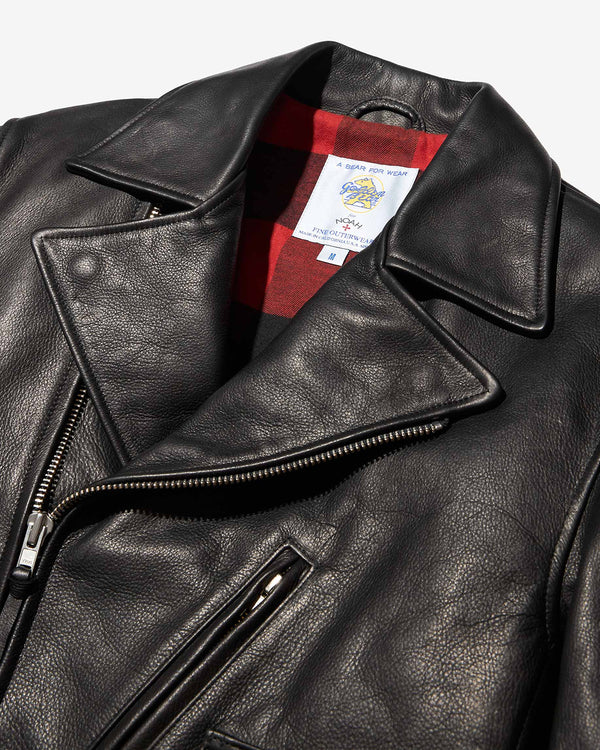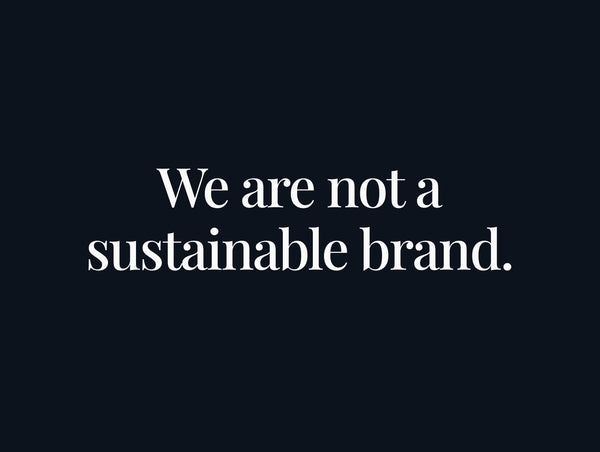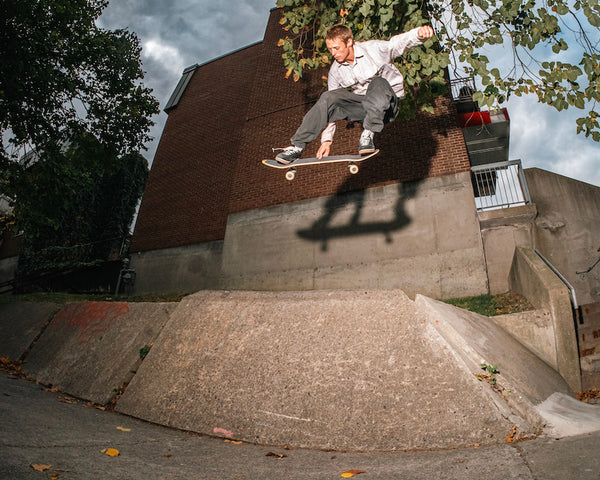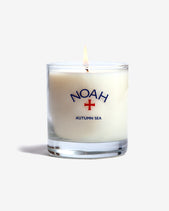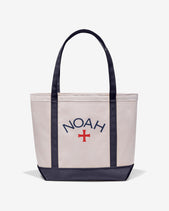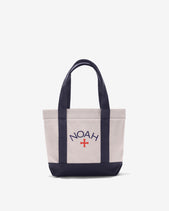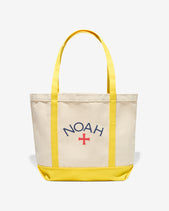
Shantell Martin
In Conversation with Estelle Bailey-Babenzien
I first met Shantell around the time Noah collaborated with The Whitney Museum two years ago. After seeing an exhibit, we chatted while walking to a dinner and I immediately felt a kinship and cultural connection with her. Like myself, a woman raised in the UK now living in New York, Shantell is of mixed race - West African and British descent.
I dug deeper into her work as an artist, listened to her Ted Talk and became a huge fan of this incredibly astute, brilliant woman. I rarely come across such fluid perception and open consciousness, it’s truly inspiring. We caught up recently at our Noah flagship store, where we’re honored to currently showcase her work alongside our Spring - Summer collection.


Estelle: I’d like to start by talking about the piece that's in the store: I love the sea, but I also like the idea of “seeing” as an interesting play on words. I’m also wondering about your process, which seems to be very in the moment–a kind of flow.
Shantell: My drawing process is very intentional in its confidence and attitude. But it's also very spontaneous and improvised. So when I'm drawing a piece like the one in the store, I'm just bringing the pen or marker to the canvas and allowing it to go where it wants. It's almost like a meditation–I'm highly present and aware, but at the same time, I'm taking a backseat, and that pen is going where it wants. But then there'll be words like “see.” I’m going to spell it S-E-A, but actually I mean it as in S-E-E. So I'm playing on that word, or the baggage that we bring to words, right? Because when you spell things in a different way, we have an emotional reflex to correct it.
So it’s a commentary on the systems that we're all part of. We bring our baggage, our experience, to all of these systems. I like mixing up “sea” and “see,” because the sea is so vast and free and open, and it's full of so much stuff. And then seeing, as in vision, potential, progress, imagination–those two are actually quite the same thing. So why not interchange them? Then I've planted that seed. When I'm trying to draw or, even with the words I use, I imagine them being like seeds. I love drawing because it's so, so simple. Literally anyone on the planet, no matter how able they are, can make a line; they can create a mark. How much work goes into that line becoming recognizable? I love these kinds of layers of simplicity and complexity.
EB: I really love the sea/see wordplay as well. Just the freedom of it, the depth, and the unlimited nature of what it is.
SM: Wrapped up in that, you have the idea of transparencies and façades, like seas that you can see through, that are clear, that give you vision. And then seas that are murky and not so translucent. I love it, because when you first look you might think, “Oh, it's a nice line drawing.” But then, if you really start to think about it, all these messages are kind of tied up in it. The more we see, the more transparent the nature of what we're seeing becomes. The more the façade comes down, the more we can actually be ourselves, because we're less of the stuff that's built around us. We're less of the façade, and more ourselves.
EB: It's almost like we've been conditioned to think, act, and be a certain way–there are all these preconceived notions and conditioning. While some of these walls are finally being broken down a little bit–especially when it comes to gender–there’s still obviously a lot of this conditioning, for example, in terms of race. And that’s been much more difficult to break down and smash open. Like you, I’m mixed race. I was raised by my white mother, and my black father wasn't in my life, so I have a very particular perspective on race and skin color and how I see it. How were you raised? What are your thoughts on seeing skin color?
SM: I also have a white mum, and a black dad. I don't know my real dad and was raised with white stepdads. I have four sisters and a brother, all blond, blue-eyed, and white. I grew up in Thamesmead on a council estate: super white, super racist, super working-class, super homophobic—all of those things. My mum had me as a teenager and didn't finish school, so there wasn’t much education in the house on multiple levels.
So I'm, like, this little brown kid that's never been told I'm different from my brother and sisters, and I have to walk out of my house every day. I don't know what your experience was like, but I remember going to school and people were like: “Shantell, why are you brown?” And I'm like, “I don't know. Maybe I've been in the sun?”
I often say, if you're mixed race, you're mixed up. Because on some level, you've not had an equal balance of culture or racial understanding.


EB: When we moved to the south of England, I started going into London and becoming more aware of my culture, and then that's when I started to begin to understand the concept of nature versus nurture.
SM: So what is your understanding of that? Are you who you are because of your nature or because of your nurture?
EB: I think it's a combination of both. Because when I finally met my biological father, when I was in my twenties, I could suddenly see the parts of me that came from him, and that weren’t like my mum. I saw myself reflected in my father for the first time. It made me more curious about the cultural aspects of my ethnicity, and what that means. But then, having come to New York, I went from being called “half-caste” in England to being “mixed race,” to…
SM: You were “half-breed,” then you were “mixed-race,” and now you're “biracial.” There're many iterations of what people call us.
EB: Yeah. We're “other.” You're not white, you're not black—you're other. Where do you fit in? You have your family, whom you love. But then you're displaced a little bit, you kind of need to find your tribe.
SM: We've always been “other,” or “outsider.” And I feel that's also allowed us to fit in everywhere and nowhere at the same time. Like there are more places that we can go in the world and naturally blend in. And, you know, I feel like that’s part of what it is to be mixed-race as well.
The first time I came to America was in 2008 or 2009, just when Barack Obama had been voted in. It was the most surreal experience seeing who’d voted for him reported on TV here. They broke it down to African-Americans, the Latinx vote, and so on. As an outsider, I always thought Americans were American–I never knew they were divided up into racial categories. Sometimes they’d say, “Oh, so-and-so’s mixed-race,” but then, on TV, they’d call him black. I wondered: why aren’t all Americans American? It just felt so... You know, it seems normal now, because I'm used to it. But then, it felt like designating a mixed-race person as black disregarded the white side of their family.
It struck me as ironic–and a missed opportunity–that America had elected a biracial president for the first time and didn’t make much of that fact. Obama was black, yes, but also biracial. Having been in this country a little longer, I see that there’s a responsibility to being black.
EB: Right. Exactly. You understand why Black Power’s been a movement in America. It's like, if there’s one drop of black blood in you, you need to come together and stand together and support each other.
SM: Absolutely. But also, from my perspective, I see how that doesn't quite allow for a spectrum of blackness, or really address different experiences of blackness.

EB: You’ve mentioned you come from an uneducated background, but you’re clearly educated. So where did your education come from?
SM: The street, you know?
EB: But I feel like it's that nature/nurture thing, right?
SM: We're from a working-class social system that keeps people in their place, and keeps them uneducated by design. I often think about it like this: I grew up in the same house, ate the same foods, had the same type of mum, and went to the same school as my brother and sisters, but we’ve had completely different lives. Then I wonder: is this because, when I’d step outside my house growing up, I’d have a completely different experience than my siblings? Did the baggage people brought to interactions with me based on the color of my skin make me believe that there must be something else? I always imagined something else that people couldn't have imagined for me.
So I’d say my true education comes from the experience of being different and other, having the personality that I was born with, and being extremely observant. Since I was a little kid, I’d see and watch and listen. There's a different type of intelligence that comes from that observational perspective. I could see the patterns in things.
Mixed with a kind of street sense, it’s given me the education and skills to get where I have in life. And now it's bizarre, because, you know, I've been at MIT, I’ve been a fellow at Columbia, and I’ve taught for many years at NYU. I've had this very academic career path, yet no one in my family finished seventh grade.
EB: I’m interested in which past experiences you’ve felt you’ve brought into your studio.
SM: Actually, a lot of my work is done outside of the studio, and ends up being site-specific. I have a project right now on Governors Island. I took over a former chapel, and turned it into an installation called “The May Room.” It's a space for freedom and contemplation and poetry. You walk in, you take your shoes off, and there's a maze in the form of a drawing on the floor, and you walk through that. Then you kind of recalibrate yourself.
On the wall, there's lots of what look like fragmented lines, but when you get closer you see they're all letters. And when you get even closer, you see they're phrases: “May you be kind.” “May we save trees.” “May you sleep soundly at night.” So it's a space for coming in and taking your shoes off, for becoming grounded, by recalibrating yourself by walking through this maze. And then when you do that and you're calm, then you see the words.




EB: So you’d say where you’re working influences what you make there.
SM: Yes, and I’ve worked in a lot of different places. I did a collaboration with the New York City Ballet, where I took over the Promenade, and another at the World Trade Center, where I took over all 21 of their screens there. I even took over all the screens in Times Square in February last year.
EB: I feel very honored that we’re able to have a piece of your art in our store! It's cool that you can do these intimate settings as well as these massive, public installations.
SM: Yeah. I think the scale's important. You know, it just closed last week, but I had my first ever museum retrospective at the New Britain Museum of American Art in Connecticut. It's actually the oldest American art museum in the country. So it was incredible to have a retrospective there that showed the last twenty, twenty-five years of my work as an artist.
EB: I would've loved to have gone to that! And you’ve had so many other exhibits and installations that have taken you far from your studio.
SM: Yeah, a lot of the things I'm actually doing are outside my studio. I have a show that's been up for a year and half at the Denver Art Museum. There was my recent collaboration with the Whitney, where I took over their store. I have a one-woman show which I performed a few times at Sotheby's and at different spaces and stages.
EB: Tell me about that.
SM: It's a 45-minute show in three parts. One part is about my life and journey, with lots of anecdotes that we can relate to. And then there's another part that talks about the importance of drawing, and why we were all given this gift and ability to draw as children and why we should continue to do it as adults. As I'm explaining this, I'm actually drawing. Then there's a final chapter with audience participation and I compose a live piece of music–I extract words from the audience and the piece will repeat those words as a chorus, which sparks a spoken-word piano piece. I've also just been commissioned by the Boston Ballet to choreograph my first ballet. So that's going to happen next year.

EB: Do you dance as well?
SM: I don't, but, you know… I draw.
EB: So you're going to create it through drawing and then translate your drawing into dance moves?
SM: That’s pretty spot on, yeah. Being invited to do something like this, you have to think: “Well, I'm not a dancer or choreographer, I don’t have that experience, but I do have experience with lines. So how about I create lines and let those inform the movements of the dance?
The piece I'm working on is called “Kites,” which takes the metaphor of a kite into consideration. It’s something uplifting that starts on the ground and goes up into the air, and the ballet will feature four paths based on separating my drawing into four parts. The lines in each of the separate sections will be almost like instructions to the dance. And they’re interchangeable. So the ballet doesn't have to be a linear ballet, with only one way of performing it; it can be, you know, jumbled around.
EB: That's a very cool way to think about it: a dance where the parts can be moved around.
SM: Yeah. It can be scary to do something like that, but if you come at it from a place of good intention, and put your true self behind it, it doesn't matter what you do. It's going to look like you, feel like you, sound like you, and move like you. As long as you’re bringing your full self to it.
EB: Yeah. That's super exciting. When's that going to be?
SM: March 2022. It was actually meant to happen in May 2021, but it got pushed back. So I'm excited about that. And yeah, then I'm working on some other cool projects that are not studio-based. Next month I'm releasing my first ever typeface: Shantell Sans.
EB: Oh, my god! That’s dope!
SM: Yeah. It's based on my handwriting, and it'll be OFL, or “open from license,” meaning anyone can use it, commercially or non-commercially.
EB: Are you going to create a book?
SM: Yeah. I'm writing the manifesto for the future of art, which I want to publish in my font, and I’ll hopefully find a cool magazine or two who might want to publish excerpts of it.




EB: So when you say manifesto on the future of art, do you mean your personal take on what that will be?
SM: Yes, it's what I envision for the future. In the 60s and 70s, a lot of artists would write manifestos about how they envisioned the future of their art. It's been a while since I’ve seen anyone do anything like that, and I’ve never done it myself. For me, it's like a piece of art which, if people see it 30 years from now, will give a sense of how someone living in my skin imagined what the future of art would look like.
EB: Does the idea of permanence matter to you? Because so much of what you’re up to seems performance-based or site-specific.
SM: My career started very unattached–I became a VJ, or visual jockey, in Japan more or less by accident. I created live-drawn digital visuals to the music and performances of DJs, dancers, and musicians. So starting out, I was comfortable with the Zen-like idea that anything I created would be destroyed soon after it was made.
Then, when I moved to New York, where VJing doesn't exist, I started to draw with pen and paper. But since I was essentially homeless during the first two years I lived here, sleeping on friends' couches, most of what I made either on paper or on walls got destroyed because I didn't have a place to keep it.
I was fine with that, because for me, what's important is the process, the experience. Which was all well and good, but now that I'm in my 40’s, it’s as though the first twenty years of my career don't exist, you know?
EB: I’m shocked to hear that so much of what you made is gone.
SM: While it's well and true to say I want my work to be experiential, I want it to be a connection, I want us to… I don't want to be too precious about it because that would take away from the process and honesty of what I was up to. But for the last ten years, I’ve had more of a focus on figuring out how to document or preserve what I create, so that it’ll have more permanence. But I still love how things like my one-woman show, which has yet to be recorded, has only been experienced by people who've attended those performances. I'm just doing it for the people and the experience, for us. That was my ethos and philosophy for most of my life.
But, now, you know, there's a reason I draw in markers as well. Because it’s permanent and you can't erase it, and you have to live with your mistakes. But you also get to share that with others for a longer period of time.
EB: Right. So a mistake isn't really a mistake when you're doing it; it just turns into something else.
SM: Well, everything is a mistake, you just have to learn to endure the process of it. But if you work with good intention, you can see that in the lines. That's why I love working with black and white, and also with markers. If I hesitate, or if I'm not confident; if I'm insecure or I haven't practiced, you can see it. Being exposed and vulnerable in this way means I have to be good, I have to practice.
EB: Do you ever go through moments now when you feel a little insecure while you’re working?
SM: No, and that's why I draw live a lot. Because when you draw live you take time away, and time is the enemy of clear thinking. When you have time to think, you have time to over-think. Whereas, when you don't have time, it means you don’t have time to be anyone else but yourself. So if you take time out of the equation, you're being as honest as you can be.

EB: I think there’s so much to be said for what’s unseen when appreciating art. The artist’s intention creates an energy that you can’t really explain, but that you can feel. That energy is really special.
SM: When I'm drawing a 16 x 40 foot wall, I'm doing it spontaneously, without thinking, and it becomes more about how to move my body in the most efficient way. And then when I finish the wall, that drawing is more confident than me. It's bigger than me. It's like a reminder that what I drew has always existed, and I just brought it to a place where we can all see it. But it was always there.
EB: When you say it was always there, do you mean it was always there because we were all brought to this place for this moment right now, or it was always there within you?
SM: Well, both, you know? If I did it tomorrow, it would be a different thing. But I feel like there’s always everything in every moment, in every time, in every space. And we have that energetic power to bring it into life.
EB: Do you study philosophy, or read philosophy?
SM: I don't read. I'm super dyslexic; and I've only read like five books in my life. But I do like thinking and observing.
EB: Does that affect you when you're writing in your paintings?
SM: Sometimes I spell things wrong! I did this massive floor mural for the New York City Ballet that took over the whole floor of the promenade at Lincoln Center, and something was spelled wrong somewhere. I can't remember what it was, because it really didn't bother me. There was a couple that came to that ballet, and they literally chased me down because they were so worried for me over that spelling mistake. But it was totally fine, because it came from me, it’s part of my art. Some people can't let go of things like that.
EB: It's interesting that you say you don't read philosophy, because you really seem like a philosopher.
SM: Well, we all learn in different ways, right? Some people think you must be smart if you read books. But if you read a lot of books, it just means you read other people’s ideas. And you can do that and be smart in a certain way. But people like myself, we just learn differently–we learn from observing and doing, from being present and seeing things others might miss.
EB: It's like the Einstein quote: if you try to teach fish how to ride a bicycle, they'll spend their whole life thinking they're stupid. Everybody truly does learn differently. Do you listen to books, audio books?
SM: Sometimes, yeah. But I mostly listen to the radio. Radio New Zealand is my go-to. They have really good programming.
EB: Why them, of all broadcasts?
SM: Well, New Zealand’s potentially the most progressive country, and they seem to be not as manipulated by their government and media environment. I found it after doing a bunch of research. They cover world news and politics, and I'd rather hear their perspective than the more polarized views you hear in America today. Radio New Zealand is still probably controlled and manipulated on some level, but there’s a different perspective that's not as tied into the polarization in America.
EB: Since we’re running short on time I’d like to ask, what about the future? Are there unrealized projects that you’d like to do one day?
SM: That’s the dilemma of being an independent artist. I’m essentially my own agency: I come up with ideas and briefs, and do copy and production and the directing and execution. But as an artist, I don't have the infrastructure or support, and thus the freedom, to do whatever I’d like. So there's tons of things I’d like to do, but don't know if I'll be able to.
I'd love to do more public art, in places like playgrounds. I'd love to use more nature, like hedges or gardens, to create experiences. Like I'd like to devote more to education, and I'd like to do more stuff on camera. I'd love to do podcasts! I have an idea for one called, “London, What Have I Missed, What Am I Missing?” Because I left London in 2003. I missed Grime. I missed culturally relevant things my people were up to. I'd love to do a show with someone like Stormzy and learn more about my people.
 The Whitney Museum 2021, NYC. Images Courtesy Shantell Martin
The Whitney Museum 2021, NYC. Images Courtesy Shantell Martin
